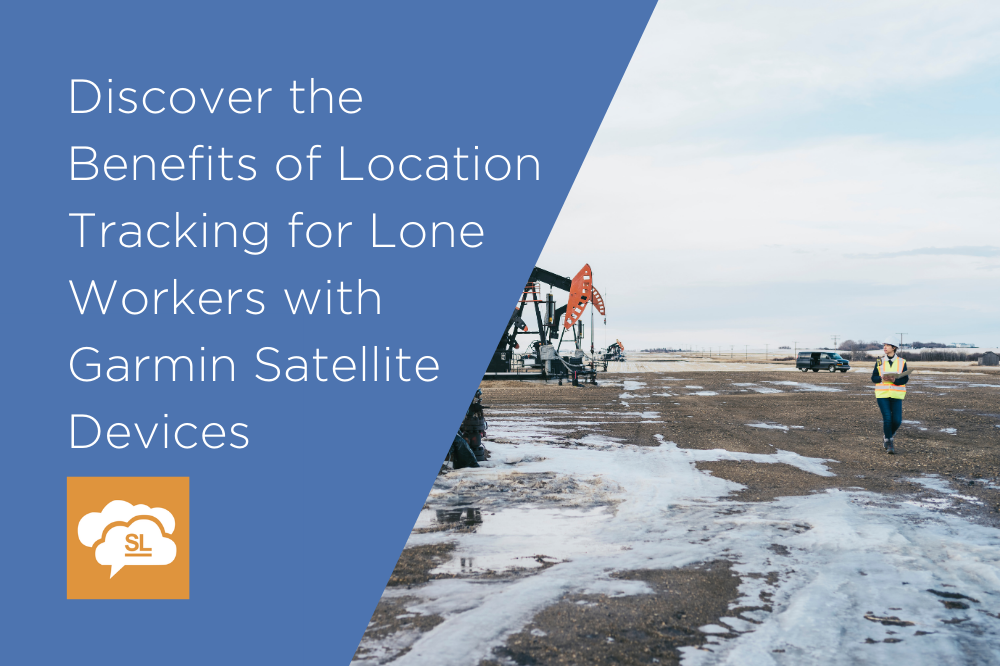Discover the Benefits of Location Tracking for Lone Workers with Garmin Satellite Devices
Table of Contents
Why satellite devices are essential for remote lone worker safety
3 questions every employer should ask about location tracking
Stay connected—even without cell signal
Communication builds safety of remote lone workers
From the military to the worksite: A brief history of satellite tracking
Benefits of Garmin inReach devices
Policy considerations: tracking devices and vehicles
Build a lone worker location tracking policy
Better together: SafetyLine + Garmin inReach
Why satellite devices are essential for remote lone worker safety
Did you know there are more than 3,000 satellites orbiting Earth right now—transmitting billions of signals that help keep people safe? For remote lone workers operating in areas with little or no cellular coverage, satellite technology can be the difference between life and death. When seconds count in an emergency, being able to transmit your location through satellite means help can be dispatched faster and more accurately.
For thousands of workers whose “office” is the outdoors—on rural highways, isolated job sites, or deep in the backcountry—reliable communication is often their greatest safety challenge. That’s why we’re proud to share that SafetyLine is now an authorized seller of Garmin’s inReach satellite devices, designed to extend safety coverage where cellular networks fall short.
“Helping provide such cutting-edge worker-location technology is very exciting for us,” says Gabriel Caldwell, CTO of Tsunami Solutions, the parent company of SafetyLine. “Garmin has transformed industries like fitness, transportation, and recreation—and now, their satellite devices can help protect lone workers too.”
3 questions every employer should ask about location tracking
Before implementing any lone worker location tracking system, especially one that involves satellite devices, employers should consider:
Am I tracking team members only during work hours?
What are the goals of tracking my staff?
Am I tracking personal or company-owned vehicles and devices?
These questions help ensure your approach is ethical, legal, and aligned with your organization’s safety culture.
Stay connected—even without cell signal
With SafetyLine’s Lone Worker Safety App and Garmin inReach devices, workers in even the most remote areas stay connected. When paired with an inReach subscription, workers gain access to:
Two-way messaging
GPS navigation and live tracking
SOS emergency response via the global Iridium® satellite network
This seamless integration allows workers to check in regularly, send alerts, and share their live location—all while maintaining compliance with your organization's safety protocols.
SafetyLine’s safety app also offers check-ins, fall detection, and panic buttons—tools that have helped protect lone and remote workers for over 20 years.
Communication builds safety of remote lone workers
The question every safety manager must ask is:
“In an emergency, can I reach my worker and send help?”
Open communication about location tracking is key to building trust. Your team should know:
When they are being tracked?
Why tracking is necessary?
How it helps protect them?
Transparency not only builds a stronger safety culture—it also helps with compliance and cooperation.
From the military to the worksite: A brief history of satellite tracking
Satellite location tracking began in the 1960s when the U.S. Navy used satellites to track nuclear submarines. Today, this technology helps guide everything from ride-share drivers to marathon runners. Now, with tools like Garmin inReach, it's safeguarding remote workers in industries like construction, forestry, oil & gas, water utilities, and home healthcare.
Benefits of Garmin inReach devices
Reliable communication even without cell coverage
Real-time GPS navigation and live tracking
SOS alerts to 24/7 emergency response centers
Seamless integration with SafetyLine’s check-in system
Extend your safety reach into rural or backcountry locations
Policy considerations: tracking devices and vehicles
If you plan to track company-owned vehicles or devices like phones and tablets, make sure employees:
Know when they’re being tracked
Understand the purpose of tracking
Provide informed consent (especially off-hours)
Ask yourself:
Is the device used only during work?
Does tracking help protect the employee or company?
Is tracking limited to work hours and locations?
If the answer to these is unclear—or if the device is personal—tracking may not be appropriate without explicit consent.
Build a lone worker location tracking policy
Even in jurisdictions where consent isn’t legally required, developing a transparent Location Tracking Policy is one of the best ways to ensure respectful, ethical use of this technology.
Your policy should outline:
What data is collected
How it will be used
Who can access it
How long it will be stored
Security protocols for that data
Location tracking with Garmin satellite devices is a game-changer for lone worker safety in remote areas. Enhance your safety protocols with our Lone Worker Safety Solution App and explore our pricing options. Visit our FAQ page for more insights, and learn about the benefits of our solutions.
Need help developing a lone worker policy? Visit our blog A Lone Worker Policy Guide: Create a Safety Policy for Your Lone Workers in Your Organization to learn more and download our lone worker policy template.
Better together: SafetyLine + Garmin inReach
Whether you’re a safety manager in oil & gas, a public works director, or leading a healthcare agency—SafetyLine combined with Garmin inReach delivers unmatched peace of mind.
Together, we help your team:
Stay visible, even beyond cellular range
Get emergency support, wherever they are
Strengthen lone worker protection with proactive, automated monitoring
To learn more about how you can benefit the safety of your remote lone workers using SafetyLine’s lone worker safety app please connect with us below:

